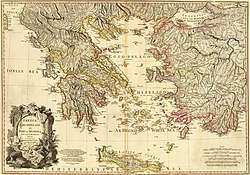
Back Griekse Donker Eeue Afrikaans Dunkle Jahrhunderte (Antike) ALS العصور المظلمة اليونانية Arabic Edá escura griega AST Qaranlıq əsrlər (Qədim Yunanıstan) Azerbaijani Грэчаскія Цёмныя стагоддзі Byelorussian Ранножелязна епоха (Гърция) Bulgarian গ্রিক অন্ধকার যুগ Bengali/Bangla Edat fosca grega Catalan Temné období Czech
| Geographical range | Greek mainland and Aegean Sea |
|---|---|
| Period | Ancient Greece |
| Dates | c. 1050 BC – c. 800 BC |
| Characteristics | Destruction of settlements and collapse of the socioeconomic system |
| Preceded by | Mycenaean Greece, Minoan civilization |
| Followed by | Archaic Greece |
| History of Greece |
|---|
 |
|
|
The Greek Dark Ages was the period of Greek history, (c. 1050-800 BC), currently known as Prehistoric Iron Age or Early Iron Age, which included all the ceramic periods from the Protogeometric to the Middle Geometric I.[1] It lasted to the beginning of the Protohistoric Iron Age around 800 BC,[2][3] and followed the Postpalatial Bronze Age (c. 1200-1050 BC).[1]
At the beginning of the Postpalatial Bronze Age, the so-called Late Bronze Age collapse of civilisation in the Eastern Mediterranean world in c. 1200-1150 took place, as the great palaces and cities of the Mycenaeans were destroyed or abandoned. At around the same time, the Hittite civilization also suffered serious disruption, with cities from Troy to Gaza being destroyed. In Egypt, the New Kingdom fell into disarray, leading to the Third Intermediate Period of Egypt. Following the collapse, there were fewer, smaller settlements, suggesting widespread famine and depopulation. In Greece, the Linear B script used by Mycenaean bureaucrats to write the Greek language ceased to be used, and the Greek alphabet did not develop until the beginning of the Protohistoric Iron Age, c. 800 BC.[4] The decoration on Greek pottery after about 1050 BC lacks the figurative decoration of Mycenaean ware and is restricted to simpler, generally geometric styles (1050–700 BC).
It was previously thought that all contact was lost between mainland Hellenes and foreign powers during this period, yielding little cultural progress or growth. But archaeologist Alex Knodell considers that artifacts from excavations at Lefkandi on the Lelantine Plain in the island of Euboea in the 1980s "revealed that some parts of Greece were much wealthier and more widely connected than traditionally thought, as a monumental building and its adjacent cemetery showed connections to Cyprus, Egypt, and the Levant as markers of elite status and authority, much as they had been in previous periods",[5] and this shows that significant cultural and trade links with the east, particularly the Levant coast, developed from c. 900 BC onwards. Additionally, evidence has emerged of the new presence of Hellenes in sub-Mycenaean Cyprus and on the Syrian coast at Al-Mina.
During the Dark Ages of Greece, the old major settlements were abandoned (with the notable exception of Athens), and the population dropped dramatically. Within these three hundred years, the people of Greece lived in small groups that moved constantly in accordance with their new pastoral lifestyle and livestock needs, while they left no written record behind leading to the conclusion that they were illiterate. Thomas R. Martin, considers that later on (between 950 and 750 BC), the Greeks relearned how to write, but using the alphabet of the Phoenicians instead of the Linear B script used by the Mycenaeans, innovating in a fundamental way by introducing vowels as letters. "The Greek version of the alphabet eventually formed the base of the alphabet used for English today."[6]
Life was harsh for the Greeks of the Dark Ages. One major result of the period was the deconstruction of the old Mycenaean economic and social structures. The strict class hierarchies and hereditary rule were forgotten, and gradually replaced with new socio-political institutions that eventually allowed for the rise of democracy in 5th c. BC Athens. Notable events from the Dark Ages period that mark the transition to Classical Antiquity include the first Olympics, in 776 BC, and the composition of the Homeric epics the Iliad and the Odyssey.
- ^ a b Knodell 2021, p. 7 Table 1.
- ^ "The History of Greece". Hellenicfoundation.com. Archived from the original on 2016-12-07. Retrieved 2024-04-21.: "The period from 1100 to 800 B.C. is known as the Dark Age of Greece. As described in the Ancient Greek Thesaursus: Throughout the area there are signs of a sharp cultural decline. Some sites, formerly inhabited, were now abandoned."
- ^ Martin, Thomas R., (October 3, 2019). "The Dark Ages of Ancient Greece": "...The Near East recovered its strength much sooner than did Greece, ending its Dark Age by around 900 B.C...The end of the Greek Dark Age is traditionally placed some 150 years after that, at about 750 B.C..." Retrieved October 24, 2020
- ^ Knodell 2021, p. 11.
- ^ Knodell, Alex (2021). Societies in Transition in Early Greece: An Archaeological History. Oakland: University of California Press. p. 11.
- ^ Martin, Thomas R., (October 3, 2019). "The Dark Ages of Ancient Greece": "Sometime between about 950 and 750 B.C. the Greeks adopted a Phoenician alphabet to represent the sounds of their own language, introducing important changes to the script by representing the vowels of their own language as letters. The Greek version of the alphabet eventually formed the basis of the alphabet used for English today." Retrieved April 21, 2024.
© MMXXIII Rich X Search. We shall prevail. All rights reserved. Rich X Search